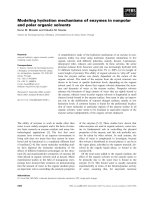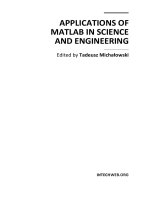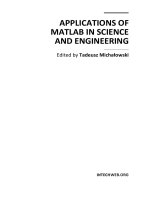Enzymes in fruit and vegetable processing chemistry and engineering applications
Bạn đang xem bản rút gọn của tài liệu. Xem và tải ngay bản đầy đủ của tài liệu tại đây (6.01 MB, 373 trang )
Enzymes in Fruit and
Vegetable Processing
Chemistry and Engineering Applications
© 2010 Taylor and Francis Group, LLC
94335.indb 1
3/31/10 4:29:03 PM
© 2010 Taylor and Francis Group, LLC
94335.indb 2
3/31/10 4:29:04 PM
Enzymes in Fruit and
Vegetable Processing
Chemistry and Engineering Applications
Boca Raton London New York
CRC Press is an imprint of the
Taylor & Francis Group, an informa business
© 2010 Taylor and Francis Group, LLC
94335.indb 3
3/31/10 4:29:04 PM
CRC Press
Taylor & Francis Group
6000 Broken Sound Parkway NW, Suite 300
Boca Raton, FL 33487-2742
© 2010 by Taylor and Francis Group, LLC
CRC Press is an imprint of Taylor & Francis Group, an Informa business
No claim to original U.S. Government works
Printed in the United States of America on acid-free paper
10 9 8 7 6 5 4 3 2 1
International Standard Book Number-13: 978-1-4200-9434-3 (Ebook-PDF)
This book contains information obtained from authentic and highly regarded sources. Reasonable efforts
have been made to publish reliable data and information, but the author and publisher cannot assume
responsibility for the validity of all materials or the consequences of their use. The authors and publishers
have attempted to trace the copyright holders of all material reproduced in this publication and apologize to
copyright holders if permission to publish in this form has not been obtained. If any copyright material has
not been acknowledged please write and let us know so we may rectify in any future reprint.
Except as permitted under U.S. Copyright Law, no part of this book may be reprinted, reproduced, transmitted, or utilized in any form by any electronic, mechanical, or other means, now known or hereafter invented,
including photocopying, microfilming, and recording, or in any information storage or retrieval system,
without written permission from the publishers.
For permission to photocopy or use material electronically from this work, please access www.copyright.
com ( or contact the Copyright Clearance Center, Inc. (CCC), 222 Rosewood
Drive, Danvers, MA 01923, 978-750-8400. CCC is a not-for-profit organization that provides licenses and
registration for a variety of users. For organizations that have been granted a photocopy license by the CCC,
a separate system of payment has been arranged.
Trademark Notice: Product or corporate names may be trademarks or registered trademarks, and are used
only for identification and explanation without intent to infringe.
Visit the Taylor & Francis Web site at
and the CRC Press Web site at
Contents
Preface................................................................................................................ vii
The Editor............................................................................................................ix
List of Contributors............................................................................................xi
Chapter 1 Introduction to Enzymes............................................................ 1
Alev Bayındırlı
Chapter 2 Effect of Enzymatic Reactions on Color of Fruits
and Vegetables............................................................................ 19
J. Brian Adams
Chapter 3 Major Enzymes of Flavor Volatiles Production and
Regulation in Fresh Fruits and Vegetables.......................... 45
Jun Song
Chapter 4 Effect of Enzymatic Reactions on Texture of Fruits
and Vegetables............................................................................ 71
Luis F. Goulao, Domingos P. F. Almeida,
and Cristina M. Oliveira
Chapter 5 Selection of the Indicator Enzyme for Blanching
of€Vegetables............................................................................. 123
Vural Gökmen
Chapter 6 Enzymatic Peeling of Citrus Fruits...................................... 145
Maria Teresa Pretel, Paloma Sánchez-Bel,
Isabel Egea, and€Felix Romojaro
Chapter 7 Use of Enzymes for Non-Citrus Fruit Juice
Production................................................................................. 175
Liliana N. Ceci and Jorge E. Lozano
v
© 2010 Taylor and Francis Group, LLC
94335.indb 5
3/31/10 4:29:06 PM
vi
Contents
Chapter 8 Enzymes in Citrus Juice Processing.................................... 197
Domenico Cautela, Domenico Castaldo, Luigi Servillo,
and€Alfonso Giovane
Chapter 9 Use of Enzymes for Wine Production.................................. 215
Encarna Gómez-Plaza, Inmaculada Romero-Cascales,
and€Ana Belén Bautista-Ortín
Chapter 10 Effect of Novel Food Processing on Fruit
and Vegetable Enzymes.......................................................... 245
Indrawati Oey
Chapter 11 Biosensors for Fruit and Vegetable Processing................. 313
Danielle Cristhina Melo Ferreira, Lucilene Dornelles Mello,
Renata Kelly Mendes, and Lauro Tatsuo Kubota
Chapter 12 Enzymes in Fruit and Vegetable Processing: Future
Trends in Enzyme Discovery, Design, Production,
and Application........................................................................ 341
Marco A. van den Berg, Johannes A. Roubos,
and Lucie Parˇenicová
Index................................................................................................................. 359
© 2010 Taylor and Francis Group, LLC
94335.indb 6
3/31/10 4:29:06 PM
Preface
Fruits and vegetables are consumed as fresh or processed into different
type of products. Some of the naturally occurring enzymes in fruits and
vegetables have undesirable effects on product quality, and therefore
enzyme inactivation is required during fruit and vegetable processing
in order to increase the product shelf-life. Commercial enzyme preparations are also used as processing aids in fruit and vegetable processing
to improve the process efficiency and product quality, because enzymes
show activity on specific substrates under mild processing conditions.
Therefore, there has been a striking growth in the enzyme market for the
fruit and vegetable industry.
While fruit and vegetable processing is the subject of many books
and other publications, the purpose of this book is to give detailed information about enzymes in fruit and vegetable processing from chemistry
to engineering applications. Chapters are well written by an authoritative author(s) and follow a consistent style. There are 12 chapters in this
book, and the chapters provide a comprehensive review of the chapter
title important to the field of enzymes and fruit and vegetable processing
by focusing on the most promising new international research developments and their current and potential industry applications. Fundamental
aspects of enzymes are given in Chapter 1. Color, flavor, and texture are
important post-harvest quality parameters of fruits and vegetables. There
are a number of product-specific details, dependent on the morphology,
composition, and character of the individual produce. Chapters 2, 3, and
4 describe in detail the effect of enzymes on color, flavor, and texture of
selected fruits and vegetables. Selection of the indicator enzyme for blanching of vegetables is summarized in Chapter 5. For enzymes as processing
aids, Chapter 6 describes in detail the enzymatic peeling of citrus fruits
and Chapter 7 presents the importance of enzymes for juice production
from pome, stone, and berry fruits. Inactivation of enzymes is required to
obtain cloudy juice from citrus fruits. Chapter 8 is related to citrus juices;
orange juice receives particular attention. Enzymes also play an important role in winemaking. The application of industrial enzyme preparations in the wine industry is a common practice. The use of enzymes for
vii
© 2010 Taylor and Francis Group, LLC
94335.indb 7
3/31/10 4:29:06 PM
viii
Preface
wine production is the focus of Chapter 9. Chapter 10 provides serious
review of the inactivation effect of novel technologies on fruit and vegetable enzymes to maximize product quality. Chapter 11 presents both
chemical and technological information on enzyme-based biosensors
for fruit and vegetable processing. The literature reported in each chapter highlights the current status of knowledge in the related area. Future
trends for industrial use of enzymes are discussed in Chapter 12. The
conclusion part of each chapter also presents the reader with potential
research possibilities and applications.
This book is a reference book to search or learn more about fruit
and vegetable enzymes and enzyme-based processing of fruit and vegetables according to the latest enzyme-assisted technologies and potential applications of new approaches obtained from university and other
research centers and laboratories. Such knowledge is important for
the companies dealing with fruit and vegetable processing to be competitive and also for the collaboration among industry, university, and
research centers.
This book is also for the graduate students and young researchers
who will play an important role for future perspectives of enzymes in
fruit and vegetable processing.
Alev Bayındırlı
© 2010 Taylor and Francis Group, LLC
94335.indb 8
3/31/10 4:29:07 PM
The Editor
Alev Bayındırlı is a professor in the Department of Food Engineering,
Middle East Technical University, Ankara, Turkey. She has authored
or co-authored 30 journal articles. She received a BS degree (1982)
from the Department of Chemical Engineering, Middle East Technical
University. MS (1985) and PhD (1989) degrees are from the Department
of Food Engineering, Middle East Technical University. She is working on food chemistry and technology, especially enzymes in fruit and
vegetable processing.
ix
© 2010 Taylor and Francis Group, LLC
94335.indb 9
3/31/10 4:29:07 PM
© 2010 Taylor and Francis Group, LLC
94335.indb 10
3/31/10 4:29:07 PM
List of Contributors
J. Brian Adams
Formerly of Campden &
Chorleywood Food Research
Association (Campden BRI)
Chipping Campden
Gloucestershire, UK
Domingos P.F. Almeida
Faculdade de Ciências
Universidade do Porto
Porto, Portugal
Escola Superior de
Biotecnologia Universidade
Católica Portuguesa
Porto, Portugal
Ana Belén Bautista-Ortín
Departamento de Tecnología
de Alimentos, Nutrición y
Bromatología
Facultad de Veterinaria,
Universidad de Murcia
Campus de Espinardo
Murcia, Spain
Alev Bayındırlı
Middle East Technical University
Department of Food Engineering
Ankara, Turkey
Inmaculada Romero-Cascales
Departamento de Tecnología
de Alimentos, Nutrición y
Bromatología
Facultad de Veterinaria,
Universidad de Murcia
Campus de Espinardo
Murcia, Spain
Domenico Castaldo
Stazione Sperimentale per le
Industrie delle Essenze e dei
Derivati dagli Agrumi (SSEA)
Reggio Calabria, Italy
Domenico Cautela
Stazione Sperimentale per le
Industrie delle Essenze e dei
Derivati dagli Agrumi (SSEA)
Reggio Calabria, Italy
Liliana N. Ceci
Planta Piloto de Ingeniería Química
UNS-CONICET
Bahía Blanca, Argentina
Isabel Egea
Departamento Biología del Estrés
y Patología Vegetal
Centro de Edafología y Biología
Aplicada del Segura-CSIC
Espinardo, Murcia, Spain
xi
© 2010 Taylor and Francis Group, LLC
94335.indb 11
3/31/10 4:29:07 PM
xii
List of Contributors
Danielle Cristhina Melo Ferreira
Institute of Chemistry
Unicamp
Campinas, São Paulo, Brazil
Lucilene Dornelles Mello
UNIPAMPA
Campus Bagé
Bagé, RS, Brazil
Alfonso Giovane
Dipartimento di Biochimica e
Biofisica
Seconda Università degli Studi di
Napoli
Napoli, Italy
Renata Kelly Mendes
Institute of Chemistry
Unicamp
Campinas, São Paulo, Brazil
Vural Gökmen
Department of Food Engineering
Hacettepe University
Ankara, Turkey
Encarna Gómez-Plaza
Departamento de Tecnología
de Alimentos, Nutrición y
Bromatología
Facultad de Veterinaria,
Universidad de Murcia
Campus de Espinardo
Murcia, Spain
Luis F. Goulao
Secção de Horticultura
Instituto Superior de Agronomia
Lisbon, Portugal
Centro de Ecofisiologia, Bioquimica
e Biotecnologia Vegetal
Instituto de Investigação
Cientifica Tropical
Oeiras, Portugal
Lauro Tatsuo Kubota
Institute of Chemistry
Unicamp
Campinas, São Paulo, Brazil
Jorge E. Lozano
Planta Piloto de Ingeniería Química
UNS-CONICET
Bahía Blanca, Argentina
Indrawati Oey
Department of Food Science
University of Otago
Dunedin, New Zealand
Cristina M. Oliveira
Secção de Horticultura
Instituto Superior de Agronomia
Lisbon, Portugal
Lucie Parˇ enicová
DSM Biotechnology Centre, DSM
Delft, The Netherlands
Maria Teresa Pretel
Escuela Politécnica Superior de
Orihuela
Universidad Miguel Hernández
Alicante, Spain
Felix Romojaro
Departamento Biología del Estrés
y Patología Vegetal
Centro de Edafología y Biología
Aplicada del Segura-CSIC
Espinardo, Murcia, Spain
Johannes A. Roubos
DSM Biotechnology Centre, DSM
Delft, The Netherlands
© 2010 Taylor and Francis Group, LLC
94335.indb 12
3/31/10 4:29:08 PM
List of Contributors
Paloma Sánchez-Bel
Departamento Biología del Estrés
y Patología Vegetal
Centro de Edafología y Biología
Aplicada del Segura-CSIC
Espinardo, Murcia, Spain
Luigi Servillo
Dipartimento di Biochimica e
Biofisica
Seconda Università degli Studi di
Napoli
Napoli, Italy
xiii
Jun Song
Agriculture and Agri-Food Canada
Atlantic Food and Horticulture
Research Centre
Nova Scotia, Canada
Marco A. van den Berg
DSM Biotechnology Centre, DSM
Delft, The Netherlands
© 2010 Taylor and Francis Group, LLC
94335.indb 13
3/31/10 4:29:08 PM
© 2010 Taylor and Francis Group, LLC
94335.indb 14
3/31/10 4:29:08 PM
chapter one
Introduction to enzymes
Alev Bayındırlı
Contents
1.1 Nature of Enzymes.................................................................................... 1
1.2 Enzyme Classification and Nomenclature............................................. 2
1.3 Enzyme Kinetics........................................................................................ 3
1.4 Factors Affecting Enzyme Activity......................................................... 7
1.5 Enzyme Inactivation............................................................................... 10
1.6 Enzymes in Fruit and Vegetable Processing........................................ 13
Abbreviations.................................................................................................... 16
References........................................................................................................... 16
1.1â•… Nature of enzymes
Enzymes are effective protein catalysts for biochemical reactions. The
structural components of proteins are L-α-amino acids with the exception
of glycine, which is not chiral. The four levels of protein structure are primary, secondary, tertiary, and quaternary structures. Primary structure is
related to the amino acid sequence. The amino group of one amino acid is
joined to the carboxyl group of the next amino acid by covalent bonding,
known as a peptide bond. The amino acid side-chain groups vary in terms
of their properties such as polarity, charge, and size. The polar amino acid
side groups tend to be on the outside of the protein where they interact
with water, whereas the hydrophobic groups tend to be in the interior part
of the protein. Secondary structure (α-helix, β-pleated sheet, and turns)
is important for protein conformation. Right-handed α-helix is a regular
arrangement of the polypeptide backbone by hydrogen bonding between
the carbonyl oxygen of one residue (i) and the nitrogenous proton of the
other residue (i+4). β-pleated sheet is a pleated structure composed of polypeptide chains linked together through interamide hydrogen bonding
between adjacent strands of the sheet. Tertiary structure refers to the threedimensional structure of folded protein. Presence of disulfide bridges,
hydrogen bonding, ionic bonding, and hydrophobic and van der Waals
interactions maintain the protein conformation. Folding the protein brings
1
© 2010 Taylor and Francis Group, LLC
94335.indb 1
3/31/10 4:29:09 PM
2
Alev Bayındırlı
together amino acid side groups from different parts of the amino acid
sequence of the polypeptide chain to form the enzyme active site that consists of a few amino acid residues and occupies a relatively small portion
of the total enzyme volume. The rest of the enzyme is important for the
three-dimensional integrity. The quaternary structure of a protein results
from the association of two or more polypeptide chains (subunits).
Specificity and catalytic power are two characteristics of an enzyme.
Most enzymes can be extremely specific for their substrates and catalyze
reactions under mild conditions by lowering the free energy requirement of the transition state without altering the equilibrium condition.
The enzyme specificity depends on the conformation of the active site.
The enzyme-substrate binding is generally explained by lock-and-key
model (conformational perfect fit) or induced fit model (enzyme conformation change such as closing around the substrate). The lock-and-key
model has been modified due to the flexibility of enzymes in solution.
The binding of the substrate to the enzyme results in a distortion of the
substrate into the conformation of the transition state, and the enzyme
itself also undergoes a change in conformation to fit the substrate. Many
enzymes exhibit stereochemical specificity in that they catalyze the reactions of one conformation but not the other. Catalytic power is increased
by use of binding energy, induced-fit, proximity effect, and stabilization
of charges in hydrophobic environment. The catalytic activity of many
enzymes depends on the presence of cofactor for catalytic activity. If the
organic compound as cofactor is loosely attached to enzyme, it is called
a coenzyme. It is called a prosthetic group when the organic compound
attaches firmly to the enzyme by covalent bond. Metal ion activators such
as Ca++, Cu++, Co++, Fe++, Fe+++, Mn++, Mg++, Mo+++, and Zn++ can be cofactors.
An enzyme without its cofactor is called an apoenzyme. An enzyme with
a cofactor is referred as a haloenzyme. Enzymes catalyze the reactions by
covalent catalysis or general acid/base catalysis.
1.2â•… Enzyme classification and nomenclature
Enzymes are classified into six groups (Table€1.1) according to the reaction
catalyzed and denoted by an EC (Enzyme Commission) number. The first,
second, and third–fourth digits of these numbers show class of the enzyme,
type of the bond involved in the reaction, and specificity of the bond,
respectively. Systematic nomenclature is the addition of the suffix -ase to
the enzyme-catalyzed reaction with the name of the substrate. For example,
naringinase, and α-L-Rhamnoside rhamnohydrolase are trivial and systematic names of the enzyme numbered as EC 3.2.1.40, respectively. Some of the
enzyme-related databases are IUBMB, International Union of Biochemistry
and Molecular Biology enzyme no menclature (www.chem.qmul. ac.uk/
iubmb/enzyme/); BRENDA, comprehensive enzyme information system
© 2010 Taylor and Francis Group, LLC
94335.indb 2
3/31/10 4:29:09 PM
Chapter one:â•… Introduction to enzymes
3
Table€1.1╇ Classification of Enzymes
EC Class
Reaction Catalyzed
−
−
EC1: Oxidoreductases
A +B A+B
EC2: Transferases
AB + C A + BC
EC3: Hydrolases
EC4: Lyases
AB + H 2O AH + BOH
X
Y
A − B A = B+ X −Y
EC5: Isomerase
X
Y
Y
X
A− B A− B
EC6: Ligases
A + B AB
Examples
Peroxidase
Catalase
Polyphenol oxidase
Lipoxygenase
Ascorbic acid oxidase
Glucose oxidase
Alcohol dehydrogenase
Amylosucrase
Dextransucrase
Transglutaminase
Invertase
Chlorophyllase
Amylase
Cellulose
Polygalacturonase
Lipase
Galactosidase
Thermolysin
Pectin lyase
Phenylalanine ammonia
lyase
Cysteine sulfoxide lyase
Hydroperoxide lyase
Glucose isomerase
Carotenoid isomerase
Hydroxycinnamate CoA
ligase
(www.brenda-enzymes.org); the ExPASy, Expert Protein Analysis System
enzyme nomenclature (www.expasy.org/enzyme/); and EBIPDB, European
Bioinformatics Institute–Protein Data Bank enzyme structures database
(www.ebi.ac.uk/thornton-srv/databases/enzymes).
1.3â•… Enzyme kinetics
Besides the quasi-steady-state kinetics (Briggs and Haldane approach),
the rate of enzyme catalyzed reactions is generally modeled by the
Michaelis-Menten approach. For a simple enzymatic reaction, binding of substrate (S) with free enzyme (E) is followed by an irreversible
© 2010 Taylor and Francis Group, LLC
94335.indb 3
3/31/10 4:29:13 PM
4
Alev Bayındırlı
breakdown of enzyme-substrate complex (ES) to free enzyme and product (P). The substrate binding with E is assumed to be very fast relative
to the breakdown of ES complex to E and P. Therefore, the substrate
binding is assumed to be at equilibrium as shown in the following reaction scheme:
k
1
2
→ ES k
→E + P
E+S ←
k
−1
(1.1)
The Michaelis-Menten approach concerns the initial reaction rate
where there is very little product formation. It is impossible to know the
enzyme concentration in enzyme preparations. Therefore, the amount of
the enzyme is given as units of activity per amount of sample. One international enzyme unit is the amount of enzyme that produces 1 micromole of product per minute. According to the applied enzyme activity
assay, the enzyme unit definition must be clearly stated in research or
application.
The total enzyme amount (Eo) equals the sum of the amount of E and
ES complex. In terms of amounts, it can be represented as follows:
CEo = CE + CES
(1.2)
The dissociation constant (Km), which is also called the MichaelisMenten constant, is a measure of the affinity of enzyme for substrate:
Km =
k−1 CECS
=
k1
CES
(1.3)
If the enzyme has high affinity for the substrate, then the reaction will
occur faster and Km has a lower value. High Km value means less affinity.
Km varies considerably from one enzyme to another and also with different substrates for the same enzyme.
For these elementary reactions 1.1, the initial reaction rate or reaction
velocity (v) is expressed as
v = k2CES
(1.4)
If the enzyme is stable during the reaction, the maximum initial reaction rate (vmax) corresponds to
vmax = k2CEo
(1.5)
© 2010 Taylor and Francis Group, LLC
94335.indb 4
3/31/10 4:29:16 PM
Chapter one:â•… Introduction to enzymes
5
If the initial concentration of substrate (So) is very high during the
reaction (CSo >> CEo), the concentration of substrate remains constant during the initial period of reaction (CSo ≈ CS). Combining Equations 1.2–1.5,
the Michaelis-Menten equation is obtained as
v=
vmaxCS
K m + CS
(1.6)
As an example, kinetic properties of polygalacturonase assayed in
different commercial enzyme preparations were studied and the reactions in all samples followed Michaelis–Menten kinetics (Ortega et al.,
2004)
Michaelis-Menten expression can be simplified as follows:
zero order expression : v = vmax
first order expression : v =
for C s >> K m
vmax
C
Km S
(1.7)
for C s << K m
(1.8)
The Michaelis-Menten plot (Figure€ 1.1a) and Lineweaver-Burk plot
(double-reciprocal plot, Figure€1.1b) are used for kinetic analyzes of data.
While a plot of v as a function of CS yields a hyperbolic curve, the doublereciprocal plot provides a straight line that is suitable for the estimation of
the kinetic constants by linear regression.
An integrated form of the Michaelis-Menten equation is also used for
the analysis of enzymatic reactions as follows:
−
dCS
v C
= max S
dt
K m + Cs
(CSo − CS ) + K m ln
CSo
CS
(1.9)
= Vmaxt
(1.10)
Another more realistic reaction scheme for one substrate reaction is
the following:
E + S ES EP E + P
(1.11)
where EP = enzyme product complex.
© 2010 Taylor and Francis Group, LLC
94335.indb 5
3/31/10 4:29:19 PM
6
Alev Bayındırlı
v
(a)
vmax
zero order with
respect to [S]
first order with
respect to [S]
Cs
1/v
(b)
slope= Km/vmax
intercept= 1/vmax
Figure 1.1╇ Michaelis–Menten plot (a) and Lineweaver–Burk plot for an enzymecatalyzed reaction obeying Michaelis–Menten kinetics (b).
Following ES formation, an enzyme product complex (EP) is produced.
This transformation may be reversible or irreversible. The velocity equation
for this more realistic reaction is easily derived by considering rapid equilibrium conditions, and it will be a function of S and P concentrations.
The Michaelis-Menten approximation is for enzyme catalysis involving only a single substrate, but in many cases the reaction involves two or
more substrates. The same approximation can be extended to two-substrate
systems. There are two types of bisubstrate reactions: sequential and pingpong reactions. Sequential reactions can be further classified as ordered
sequential or random sequential mechanism. For the pingpong mechanism, there are two states of the enzyme: E and F. F is a modified state of E
and often carries a fragment of S1. The general pathways are as follows:
Ordered sequential mechanism:
S1
S2
→ ES ←
→ ES S
→ E + P 1 + P2
E←
1
1 2
(1.12)
© 2010 Taylor and Francis Group, LLC
94335.indb 6
3/31/10 4:29:33 PM
Chapter one:â•… Introduction to enzymes
7
Random sequential mechanism:
S1
S2
→ ES ←
→ ES S
→ E + P 1 + P2
E←
1
1 2
S2
(1.13)
S1
→ ES ←
→ ES S
→ E + P 1 + P2
E←
2
1 2
(1.14)
Ping-pong mechanism:
S1
→ ES F + P
E←
1
1
(1.15)
S2
→ FS
→ E + P2
F←
2
(1.16)
1.4â•… Factors affecting enzyme activity
Besides the presence of enzyme and substrate, pH, temperature, and the
presence of inhibitors and activators are important factors for the rate of
the enzymatic reactions. Table€ 1.2 shows the Michaelis-Menten kinetic
approach for some simple enzyme inhibition types.
pH is also an important parameter for enzyme activity, since most of
the enzyme catalysis is general acid–base catalysis. The activities of many
enzymes vary with pH in a manner that can often be explained in terms
of the dissociation of acids and bases. A simple approach to pH effect is
the assumption of an enzyme with two dissociable protons and the zwitterion as the active form. The enzyme–substrate complex also may exist in
three states of dissociation, such as
ES−
E−
H+
H+
↓ ↑
→
EH ←
S+
H
+
↓↑
EH
↓ ↑
H
+
2
(1.17)
EHS
→ EH + P
+
↓↑
EH 2S+
For this case, the following velocity equation is obtained by using the
Michaelis-Menten approach
v=
K
Km 1 + a 2
C
H+
vmaxCS
C +
C +
K′
+ H + [ S] 1 + a 2 + H'
K a1
CH + K a1
(1.18)
where Ka1, Ka2, K’a1, and K’a2 are related ionization constants.
© 2010 Taylor and Francis Group, LLC
94335.indb 7
3/31/10 4:29:36 PM
Type
Competitive inhibition
Reaction
k1
2
→ ES
E + S←
→E + P
k
k2
k11
→ EI
E+ I←
k−11
Maximum velocity
and dissociation
constants
Rate expression
vmax = k2 CEo
v=
CEo = CE + CES + CEI
Km =
CECES
CES
KI =
CECI
CESI
8
© 2010 Taylor and Francis Group, LLC
94335.indb 8
Table€1.2╇ Simple Enzyme Inhibition Types and Substrate Inhibition
(
v max CS
Km 1 +
CI
KI
)+ C
S
Examples for competitive inhibition:
Anacardic acid (C15:1) inhibition of the soybean lipoxygenase-1 (EC 1.13.11.12, Type 1) catalyzed the oxidation of linoleic acid
(Kubo et al., 2006)
Kiwi fruit proteinaceous pectin methylesterase inhibitor for carrot pectin methyl esterase (Ly-Nguyen et al., 2004)
Tyrosinase (E.C. 1.14.18.1) inhibition by benzoic acid (Morales et al., 2002)
Uncompetitive inhibition
k1
2
→ ES k
E + S←
→E + P
k2
k −11
CEo = CE + CES + CESI
Km =
CECES
CES
KI =
CESCI
CESI
v=
v max CS
C
K m + CS 1 + I
KI
3/31/10 4:29:42 PM
Alev Bayındırlı
k11
→ ESI
ES + I ←
vmax = k2 CEo
Noncompetitive inhibition
k1
2
→ ES k
E + S←
→E + P
vmax = k2 CEo
k2
CEo = CE + CES + CEI + CESI
k11
Km =
v=
CECS
CES
CECI CESCI
KI =
=
CEI
CESI
→ EI
E+ I←
k−11
k22
→ ESI
ES + I ←
v max CS
CI
CI
Km 1 +
+ CS 1 + K
K
I
I
Chapter one:â•… Introduction to enzymes
© 2010 Taylor and Francis Group, LLC
94335.indb 9
Examples for uncompetitive inhibition:
Effect of a nonproteinaceous pectin methylesterase inhibitor in potato tuber which is a heavy side-branched uronic chain, on
pectin methylesterase from different plant species (McMillan and Perombelon, 1995)
p-Aminobenzenesulfonamide and sulfosalicilic acid for the catecholase activity of purified mulberry polyphenol oxidase
( Arslan et al., 2004)
Sucrose inhibition of purified papaya pectinesterase (Fayyaz et al., 1995)
k−22
Examples for noncompetitive inhibition:
Kiwi fruit proteinaceous pectin methylesterase inhibitor for banana and strawberry pectin methyl esterase (Ly-Nguyen et al., 2004)
Citric acid and oxalic acid inhibition of lettuce polyphenol oxidase (Altunkaya and Gökmen, 2008)
Sodium sulfate, citric acid and ascorbic acid inhibition of polyphenol oxidase from broccoli florets (Gawlik-Dzike et al., 2007)
Substrate inhibition
k1
2
→ ES
E + S←
→E + P
k
k2
k11
→ ESS
ES + S ←
k−11
vmax = k2CEo
CEo = CE + CES + CESS
CC
Km = E S
CES
CESCS
KI =
CESS
v=
vmax
Km
C
+ 1+ S
CS
KI
9
3/31/10 4:29:48 PM
10
Alev Bayındırlı
The simplification of this kinetic expression is possible by using
low or high [S] and low or high [H+] for the simple analysis of the enzymatic system.
The enzymatic reaction rate increases with increasing temperature to
a maximum level and then decreases with further increase of temperature
due to enzyme denaturation. Temperature effect on reaction rate constant
(k) can be expressed by Arrhenius’ equation:
k = k0e( − Ea/RT )
(1.19)
where ko and Ea are pre-exponential factor and activation energy, respectively. T is the absolute temperature in this equation.
Q10 value is also used to show the effect of temperature and is defined
as the factor by which the rate constant is increased by increasing the temperature 10°C. By considering the reaction rate constants as k1 and k2 at
temperatures of T1 and T2 (T1 + 10), respectively, the ratio of k2 to k1 will be
ln
k2 Ea T2 − T1
=
k1 R T1T2
(1.20)
According to the definition of Q10 value, it equals to k2/k1 and the following equality is obtained:
ln Q10 =
1.5
Ea 10
R T1T2
(1.21)
Enzyme inactivation
For each enzyme, there is an optimum temperature for activity, and
increasing the temperature causes enzyme denaturation. Deamidation of
asparagine and glutamine residues, hydrolysis of peptide bonds at aspartic acid residues, oxidation of cysteine residues, thiol-disulphide interchange, destruction of disulphide bonds, and chemical reaction between
enzyme and other compounds such as polyphenolics can all cause irreversible enzyme inactivation at high temperatures (Volkin & Klibanov,
1989; Adams, 1991).
Thermal enzyme inactivation is generally modeled by first-order
kinetics:
−
dCE
= kCE
dt
CE = CE0 e − kt
(1.22)
(1.23)
© 2010 Taylor and Francis Group, LLC
94335.indb 10
3/31/10 4:29:51 PM









